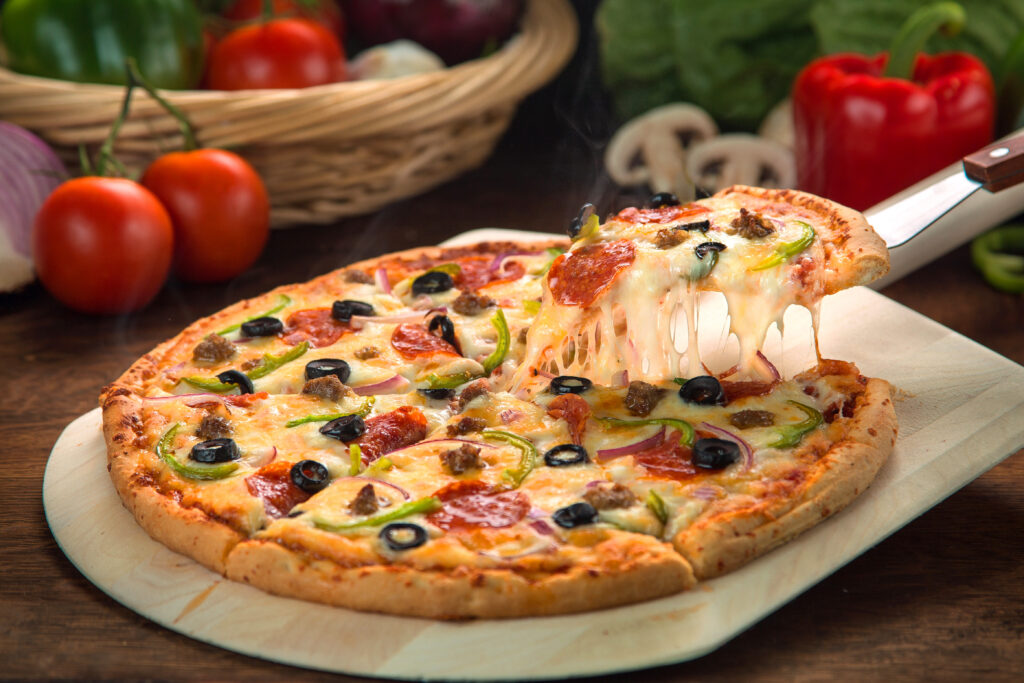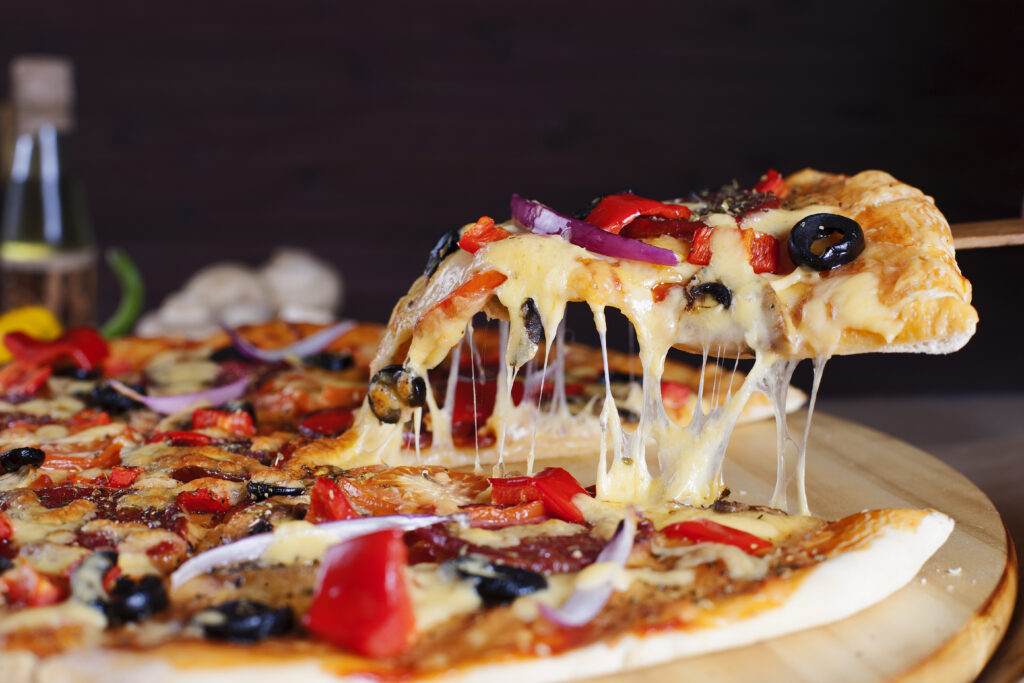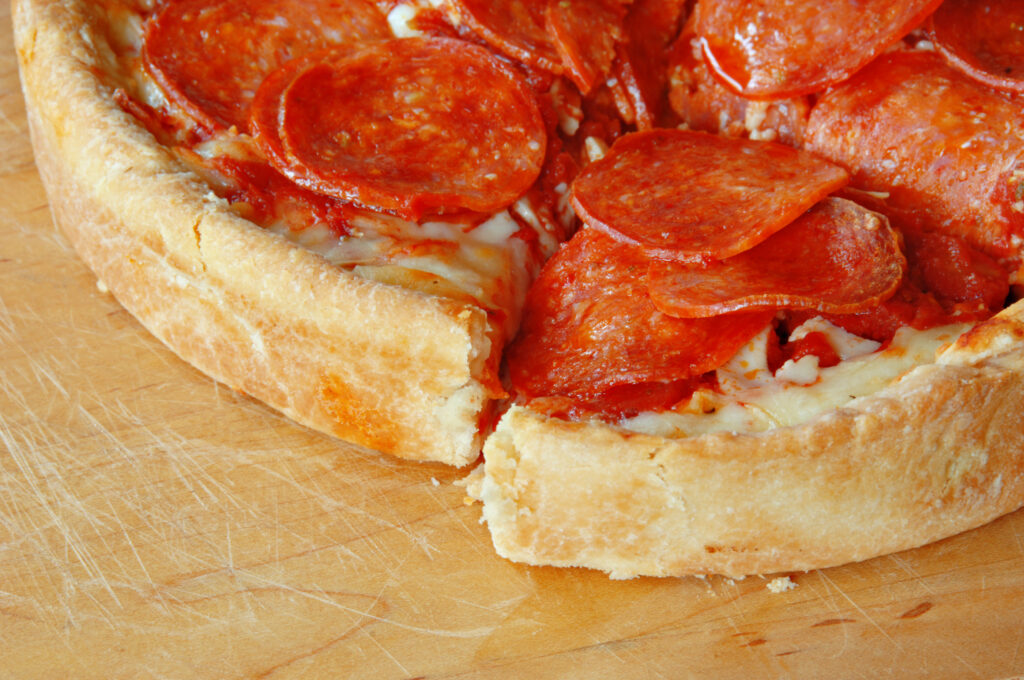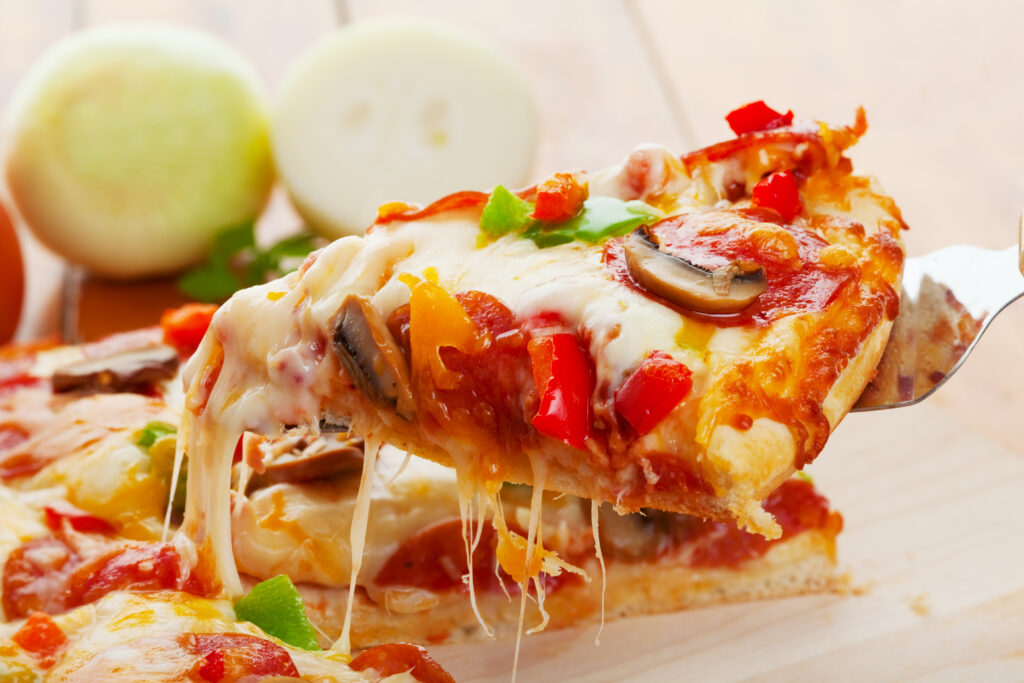Most of us regularly indulge in one or two slices of pizza, if not more. However, how many calories are there in a slice of pizza?

Understanding the calories in pizza can be useful if you’re attempting to stick to a balanced diet or are just curious about the nutritional content of your favorite cuisine.
Several factors can greatly affect how many calories there are in a slice of pizza. The nutritional content of a slice of pizza is influenced by the type of crust, the kind and quantity of cheese, the toppings, and the sauce.
For instance, a slice of stuffed-crust meat-lovers pizza from the same chain restaurant can have over 500 calories per slice whereas a slice of thin-crust cheese pizza from the same restaurant can have just 215 calories.
It’s significant to remember that unhealthy elements like highly-processed meats, added sugar and significant levels of sodium can also be found in pizza. However, depending on the ingredients utilized, pizza might also offer certain health advantages.
Vitamins, minerals, and antioxidants can be found in homemade sauces and fresh toppings. Pizza may also be made to be a healthier alternative by using gluten-free crusts and veggie toppings.
This article will examine the nutritional value of pizza, the calories in various varieties of pizza, and the advantages and disadvantages of this popular cuisine for your health.
Calories in a Slice of Pizza
When it comes to pizza, one of the most common questions is how many calories are in a slice of pizza. The answer to this question varies depending on the type of pizza, the size of the slice, and the toppings.

In this section, we will break down the number of calories in a slice of pizza based on different crust types and provide some tips for making healthier choices.
Thin Crust Pizza
Thin crust pizza is typically lower in calories than other types of pizza due to the smaller amount of crust. On average, a slice of thin-crust cheese pizza contains around 180-200 calories.
However, this number can vary depending on the toppings. For example, a slice of thin-crust pepperoni pizza can contain around 250-300 calories.
Regular Crust Pizza
Regular-crust pizza is the most common type of pizza and is typically thicker than thin-crust pizza. A slice of regular crust cheese pizza contains around 200-250 calories, while a slice of regular crust pepperoni pizza can contain around 300-350 calories.
Thick Crust Pizza

Thick-crust pizza is the highest in calories due to the larger amount of crust. A slice of thick-crust cheese pizza can contain around 300-350 calories, while a slice of thick-crust pepperoni pizza can contain around 400-450 calories.
Stuffed Crust Pizza
Stuffed crust pizza is similar to regular crust pizza but has cheese or other toppings stuffed into the crust. A slice of stuffed crust cheese pizza can contain around 350-400 calories, while a slice of stuffed crust pepperoni pizza can contain around 450-500 calories.
When it comes to making healthier choices, there are a few things to keep in mind. Opt for pizzas with lots of veggies like peppers, spinach, and mushrooms. These toppings are typically lower in calories and provide fiber and other nutrients.
Also, be mindful of the amount of cheese and fatty toppings like pepperoni, which can increase the calorie count. Finally, watch the sodium content, as many pizzas can be high in sodium.
Overall, the number of calories in a slice of pizza varies depending on the type of crust and toppings. By making healthier choices and being mindful of portion sizes, you can still enjoy pizza as part of a balanced diet.
Nutritional Information
When it comes to pizza, knowing the nutritional information is important for making informed choices about what we eat.

In this section, we will provide information on the nutritional value of a slice of pizza, as well as the healthy and unhealthy ingredients that can be found in it.
Nutritional Value
The nutritional value of a slice of pizza can vary depending on the type of pizza and the toppings. On average, a slice of cheese pizza contains around 285 calories, 10.4g of fat, 35.6g of carbohydrates, and 12.2g of protein. It also contains important nutrients such as calcium, iron, and vitamin D.
Healthy Ingredients
Pizza can be a good source of nutrients if it is made with healthy ingredients. For example, a pizza topped with vegetables such as spinach, mushrooms, and bell peppers can provide important vitamins and minerals.
Additionally, choosing a pizza made with whole wheat crust can increase the fiber content and make it a more filling option.
Unhealthy Ingredients
Unfortunately, many pizzas also contain unhealthy ingredients. Highly processed meats such as pepperoni and sausage can be high in sodium and unhealthy fats.
Additionally, many pizzas are made with a crust that is high in refined carbohydrates, which can cause blood sugar spikes and leave us feeling hungry soon after eating.
It is also important to be aware of added sugars in pizza. Some pizzas can contain sweet sauces or sugary toppings such as pineapple or barbecue sauce, which can add extra calories and contribute to health problems such as obesity and diabetes.
In conclusion, when it comes to pizza, it is important to be mindful of the ingredients and nutritional value. By choosing pizzas made with healthy ingredients and being aware of unhealthy ingredients, we can enjoy this popular food while still maintaining a balanced diet.
Pizza Brands
When it comes to pizza, there are many different brands to choose from. In this section, we will take a closer look at three popular brands: Pizza Hut, Digiorno, and Red Baron.
Pizza Hut
Pizza Hut is a well-known chain that offers both dine-in and delivery options. Their pizzas are known for their thick, doughy crust and generous toppings. Here are some nutritional facts for a slice of Pizza Hut’s cheese pizza:
| Nutrient | Amount |
|---|---|
| Calories | 220 |
| Fat | 9g |
| Carbohydrates | 26g |
| Protein | 9g |
| Sodium | 480mg |
While Pizza Hut’s pizza is tasty, it is important to note that it is not the healthiest option out there. Their pizzas can be high in calories and sodium, so it is best to enjoy them in moderation.
Digiorno
Digiorno is a popular frozen pizza brand that can be found in most grocery stores. Their pizzas are known for their crispy crust and flavorful toppings. Here are some nutritional facts for a slice of Digiorno’s cheese pizza:
| Nutrient | Amount |
|---|---|
| Calories | 190 |
| Fat | 7g |
| Carbohydrates | 22g |
| Protein | 9g |
| Sodium | 450mg |
Compared to Pizza Hut, Digiorno’s pizza is lower in calories and sodium. However, it is important to note that frozen pizzas can be high in preservatives and additives.
Red Baron
Red Baron is another popular frozen pizza brand that can be found in most grocery stores. Their pizzas are known for their thin crust and bold flavors. Here are some nutritional facts for a slice of Red Baron’s cheese pizza:
| Nutrient | Amount |
|---|---|
| Calories | 270 |
| Fat | 12g |
| Carbohydrates | 27g |
| Protein | 12g |
| Sodium | 560mg |
Red Baron’s pizza is higher in calories and sodium compared to Digiorno’s pizza. However, their pizzas are known for their bold flavors and variety of toppings.
Overall, when it comes to pizza, it is important to enjoy it in moderation. While it can be tempting to indulge in a large pizza, it is best to stick to one or two slices and pair it with a side salad or vegetable.
Making Healthier Pizza Choices
Pizza is one of our favorite foods, but it can be high in calories, saturated fat, and sodium. However, we can still enjoy pizza while making healthier choices.
Choosing Healthier Toppings
Choosing healthier toppings can make a big difference in the nutritional value of our pizza. Here are some tips:
- Load up on veggies: Add plenty of vegetables like bell peppers, onions, mushrooms, and spinach to our pizza. They are low in calories and high in fiber, vitamins, and minerals.
- Go for lean proteins: Instead of high-fat meats like pepperoni or sausage, choose lean proteins like grilled chicken, shrimp, or turkey. They are lower in saturated fat and calories.
- Choose low-fat cheese: Opt for lower-fat cheeses like part-skim mozzarella or feta. They are lower in calories and saturated fat.
Making Homemade Pizza
Making homemade pizza is a great way to control the ingredients and make a healthier pizza. Here are some tips:
- Use whole wheat crust: Whole wheat crust is higher in fiber and nutrients than white crust. We can also try cauliflower crust for a lower-carb option.
- Make our own sauce: Homemade sauces are often lower in sugar and sodium than store-bought sauces. We can use fresh tomatoes, garlic, herbs, and spices to make a delicious sauce.
- Use healthy toppings: We can pile on the veggies and lean proteins to make a healthier pizza. We can also experiment with new toppings like artichokes, olives, or roasted red peppers.
Reading Nutrition Labels
Reading nutrition labels can help us make informed choices about the pizza we eat. Here are some things to look for:
- Calories: Choose pizzas with fewer calories per serving.
- Saturated fat: Limit our intake of saturated fat, which can increase our risk of heart disease.
- Fiber: Look for pizzas with higher fiber content, which can help us feel full and satisfied.
- Cholesterol: Limit our intake of cholesterol, which can increase our risk of heart disease.
- Sugar: Choose pizzas with lower sugar content, which can help us maintain a healthy weight.
By following these tips, we can enjoy pizza while making healthier choices for our bodies.







Add comment